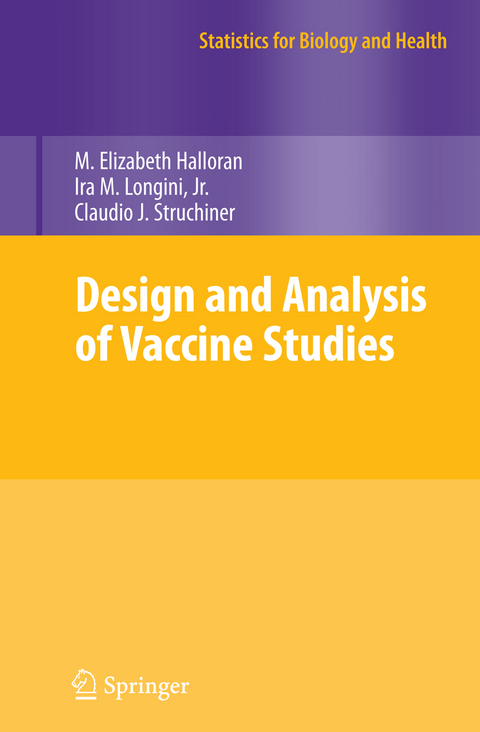
Design and Analysis of Vaccine Studies
Seiten
2012
Springer-Verlag New York Inc.
978-1-4614-2488-8 (ISBN)
Springer-Verlag New York Inc.
978-1-4614-2488-8 (ISBN)
As well as being a reference for the design, analysis, and interpretation of vaccine studies, the text covers all design and analysis stages, from vaccine development to post-licensure surveillance, presenting likelihood, frequentists, and Bayesian approaches.
Immunizationisoneofthegreatadvancesinpublichealth. Figure0. 1showsacamel with a solar-powered refrigerator on his back carrying vaccines across a hot desert to the far reaches of civilization. Many vaccines contain live viruses that need to be kept cold, or the vaccine viruses will die, and the vaccines will lose their ability to produce an immune response. Thus a continuous chain of refrigeration, the cold chain, from the origin to delivery of some vaccines needs to be maintained. The inspiration of the camel image is that it represents the dedication of the world to bring vaccines to everyone. The ?rst major success, and the origin of the word vaccination (vacca for cow), was Jenner's introducing cowpox-based vaccine against smallpox in the late 18th century. After nearly a century hiatus, at the end of the 19th century, inoculations against cholera, typhoid, plague (caused by bacteria) and rabies (caused by a virus) were developed. By the early 20th century, statisticians of the stature of Karl Pe- son, Major Greenwood, and Udny Yule were heartily involved in discussions of evaluating these vaccines in the ?eld.
In the 1920s, new vaccines included pert- sis, diptheria, tetanus, and bacille Calmette-Guerin ' against tuberculosis. The 1930s saw development of yellow fever, in?uenza, and rickettsia vaccines. After World War II, the advent of cell cultures in which viruses could grow enabled production of polio vaccine and vaccines against measles, mumps, rubella, varicella, and a- novirus, among others (Plotkin et al 2008).
Immunizationisoneofthegreatadvancesinpublichealth. Figure0. 1showsacamel with a solar-powered refrigerator on his back carrying vaccines across a hot desert to the far reaches of civilization. Many vaccines contain live viruses that need to be kept cold, or the vaccine viruses will die, and the vaccines will lose their ability to produce an immune response. Thus a continuous chain of refrigeration, the cold chain, from the origin to delivery of some vaccines needs to be maintained. The inspiration of the camel image is that it represents the dedication of the world to bring vaccines to everyone. The ?rst major success, and the origin of the word vaccination (vacca for cow), was Jenner's introducing cowpox-based vaccine against smallpox in the late 18th century. After nearly a century hiatus, at the end of the 19th century, inoculations against cholera, typhoid, plague (caused by bacteria) and rabies (caused by a virus) were developed. By the early 20th century, statisticians of the stature of Karl Pe- son, Major Greenwood, and Udny Yule were heartily involved in discussions of evaluating these vaccines in the ?eld.
In the 1920s, new vaccines included pert- sis, diptheria, tetanus, and bacille Calmette-Guerin ' against tuberculosis. The 1930s saw development of yellow fever, in?uenza, and rickettsia vaccines. After World War II, the advent of cell cultures in which viruses could grow enabled production of polio vaccine and vaccines against measles, mumps, rubella, varicella, and a- novirus, among others (Plotkin et al 2008).
and Examples.- Overview of Vaccine Effects and Study Designs.- Immunology and Early Phase Trials.- Binomial and Stochastic Transmission Models.- and Deterministic Models.- Evaluating Protective Effects of Vaccination.- Modes of Action and Time-Varying VE.- Further Evaluation of Protective Effects.- Vaccine Effects on Post-Infection Outcomes.- Household-Based Studies.- Analysis of Households in Communities.- Analysis of Independent Households.- Assessing Indirect, Total, and Overall Effects.- Randomization and Baseline Transmission.- Surrogates of Protection.
| Reihe/Serie | Statistics for Biology and Health |
|---|---|
| Zusatzinfo | XVIII, 390 p. |
| Verlagsort | New York, NY |
| Sprache | englisch |
| Maße | 155 x 235 mm |
| Themenwelt | Mathematik / Informatik ► Mathematik ► Wahrscheinlichkeit / Kombinatorik |
| Medizin / Pharmazie ► Medizinische Fachgebiete ► Pharmakologie / Pharmakotherapie | |
| Studium ► Querschnittsbereiche ► Epidemiologie / Med. Biometrie | |
| Studium ► Querschnittsbereiche ► Infektiologie / Immunologie | |
| Technik ► Medizintechnik | |
| Schlagworte | Impfung |
| ISBN-10 | 1-4614-2488-7 / 1461424887 |
| ISBN-13 | 978-1-4614-2488-8 / 9781461424888 |
| Zustand | Neuware |
| Haben Sie eine Frage zum Produkt? |
Mehr entdecken
aus dem Bereich
aus dem Bereich
ein überfälliges Gespräch zu einer Pandemie, die nicht die letzte …
Buch | Hardcover (2024)
Ullstein Buchverlage
24,99 €


